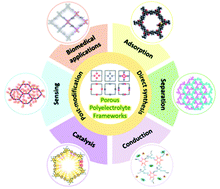Porous polyelectrolyte frameworks: synthesis, post-ionization and advanced applications
Abstract
Porous organic polymers (POPs), which feature high surface areas, robust skeletons, tunable pores, adjustable functionality and versatile applicability, have constituted a designable platform to develop advanced organic materials. Endowing polyelectrolytes with the distinct characteristics of POPs will attract mounting interest as the structural diversity of polyelectrolytes will bring the new hope of intriguing applications and potential benefits. In this review, the striking progress in ionized POPs (i-POPs) has been systematically summarized with regard to their synthetic strategies and applications. In the synthesis of i-POPs, we illustrate the representative ionic building blocks and charged functional groups capable of constructing the polyelectrolyte frameworks. The synthetic methods, including direct synthesis and post-modification, are detailed for the i-POPs with amorphous or crystalline structures, respectively. Subsequently, we outline the distinctive performances of i-POPs in adsorption, separation, catalysis, sensing, ion conduction and biomedical applications. The survey concerns the interplay between the surface chemistry, ionic interaction and pore confinement that cooperatively promote the performance of i-POPs. Finally, we conclude with the remaining challenges and promising opportunities for the on-going development of i-POPs.

- This article is part of the themed collection: Future Applications and Techniques using Porous Organic Polymers


 Please wait while we load your content...
Please wait while we load your content...